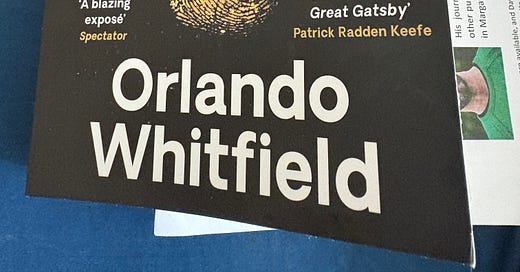All That Glitters
Orlando Whitfield
How well do you know your best friend? This was the question Orlando Whitfield found himself asking about the highly intelligent, knowledgeable and anarchic friend, Inigo Philbrick, that he met studying History of Art at Goldsmiths in the early noughties.
Both young men had fathers rooted in the art world. Whitfield’s father had been managing director of Christies, the famous auction house, while Philbrick’s was director of the Aldrich Contemporary Art Museum in southern Connecticut, while his grandfather ran a fine art foundry and his mother was an artist.
Philbrick didn’t attend many of the lectures at Goldsmiths, which added to his mystique, but when he did, he sounded more like a lecturer than a student, asserting his views with no uncertainty and exhibiting an insouciance that suggested he didn’t care what anyone else thought of him.
It was perhaps this confidence that propelled Philbrick into an orbit rarely seen by people of his relative inexperience. His father had arranged for him to have a holiday job at the White Cube Gallery in London before starting university, and his absolute lack of doubt and brisk certainty impressed the important art figures he met.
Although Whitfield and Inigo had many fun times as students, once they had graduated, Philbrick’s pursuit of success as a secondary art dealer - someone selling not primarily in galleries, but privately, to wealthy collectors - meant that a distance developed between the men. Whitfield always felt insecure and inferior in career terms by comparison with Philbrick, because the latter had a talent for dazzling important figures who helped him in his stratospheric climb. Jay Joplin, of the White Cube Gallery, was soon business partners with Philbrick, and financing a gallery in a prime area of central London for Philbrick to use as his base. Philbrick charmed other important figures in the same easy way. He knew what he was talking about when it came to modern art, and he was adept at making excellent deals which enriched both him and his wealthy collaborators.
Whitfield explains the running of the art market with lucidity, and it becomes very apparent to the reader that this is a field that is largely unregulated. There is little or no transparency. Art galleries often do not display prices, but make them available ‘on request.’ Secondary dealers can inflate the price they are asking for a piece by artificially inflating the price of that artist’s work by various means. It is not unknown for a multi-millionaire artist like Damien Hirst to bid on his own work in an auction, driving the price up higher and higher, albeit he would probably do it through a company of which he was part owner, and would not be physically present at the auction. He is in fact, the owner of some of his most expensive works sold at auction.
The other thing Whitfield makes clear is that the market price of a piece of art is not a statement of its true worth, whatever that may be. It is simply the amount that someone was willing to buy it. There have been numerous artists whose work has sold for hundreds of thousands because they were all the rage for a certain moment in time, and expedience was used to drive their prices ever higher, only for their prices to drop dramatically to less than half or a quarter what it was at its peak.
Whitfield loves his friend, even though Philbrick doesn’t always act loyally. Even while they are still at university, there is an occasion when Philbrick double-crosses him when they are making an early joint deal. Philbrick also jealously guards his contacts, never offering to give Whitfield a leg up; even when he offers him a job at his gallery, it is a basic job for a paltry wage, and there is no warm camaraderie except for the rare occasions on which Philbrick is available to go out with his old friend one-to-one.
An early red flag unfurls at the way Philbrick’s important friendships all seem to disintegrate in time, although it’s easy to assume that this is simply because two highly driven individuals raking in millions every year are bound to be assertive about their wishes.



